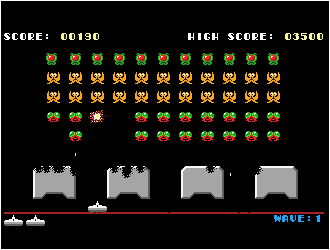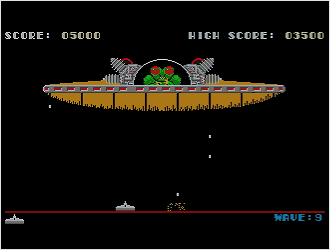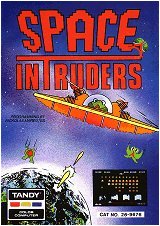 With Space Intruders, I decided to go
retro. Up until now, all my games have been original concepts derived from
elements from other games. This time I have taken the classic arcade game
of Space Invaders (actually Space Invaders Part 2) and jazzed up the graphics. With Space Intruders, I decided to go
retro. Up until now, all my games have been original concepts derived from
elements from other games. This time I have taken the classic arcade game
of Space Invaders (actually Space Invaders Part 2) and jazzed up the graphics.
There were many Space Invaders clones for the original Tandy Color Computer
over the years but none that I felt were anywhere near as good as the original.
There were certainly none written for the new Color Computer 3 at the time and that is
probably because Space Invaders was a dated idea. I hoped that by giving
the graphics a graphical update, it may give it a new lease of life. Plus,
Space Invaders is a simpler game to create and this would give me an opportunity
to try some news routines I had been designing for the new Color Computer
3.
Original Story Pretext
"Enemy alien creatures have been identified entering our solar system,
their destination, our home planet! Their goal, the total annihilation of
our race. They must not be allowed to land!
As you position yourself at the helm of a giant particle beam laser cannon,
you sense that sinister rhythm of the Space Intruders as they break through
the cloud cover. You immediately unleash the awesome power of your cannon
destroying them one by one as they descend towards the planet surface.
Suddenly a report comes to you from control headquarters. A gigantic alien
vessel has also entered the solar system. Could it be the Alien Superior?!"
A bloated description that basically says, "Get the buggers before they get
you!" :)
Game Development
 In designing the new graphics for Space
Intruders, I wanted something that looked contemporary but still retained
elements of the classic graphics used in the original arcade masterpiece.
The image on the right lets you compare the differences. As you can see,
the new enhanced graphics still bare a strong similarity with the original. In designing the new graphics for Space
Intruders, I wanted something that looked contemporary but still retained
elements of the classic graphics used in the original arcade masterpiece.
The image on the right lets you compare the differences. As you can see,
the new enhanced graphics still bare a strong similarity with the original.
Another reason I chose to do a less ambitious game was that I was exploring
new ideas for graphics and sound engines. My old graphics engine created
all the graphics "offline" in memory and then switched the displayed page
to this offline image when a frame was complete. This time, I did everything
on one screen. This was also due to the number of moving characters, 55 in
all, that would have created a bigger slowdown than what I experienced in
Rupert Rythym had I used my old techniques.
I also experimented for the first time with "interrupt driven routines".
The idea was to set up the player's laser base object to be interrupt driven.
The main program would only drive the alien invaders, sound and all missiles
while a separate subroutine was called up at fixed intervals via a hardware
interrupt that would move the player's laser base left and right. It worked
very well with the laser base moving silky smooth. I recall a few moments
during development when the program would crash and everything on the screen
would freeze or corrupt yet the laser base continued to move smoothly left
and right across the bottom of the screen. I liked this interrupt driven
stuff and I had to find other ways of using them in the future!

The aliens are coming! |

Wave 9 - The Mothership! |
I did add some extra innovation to the old game of Space Invaders. In the
original, you can never win. You are presented with wave after wave of enemy
invaders till you finally expire all your laser bases. In Space Intruders,
there are 8 waves of progressively harder rounds and in wave 9, the Mother
Ship arrives! This part of the game is modelled on arcade "Pheonix" and you
are required to penetrate the base of the Mother Ship and eventually shoot
the Alien Superior within before the vessel lands and invades Earth. Succeeding
this, you actually win the game!
Marketing and Sales
 Again, Tandy Australia marketed my
game. Again I created a rough sketch of the artwork I wanted and a commercial
artist created a final sketch. Tandy allocated a Catalogue Number and I arranged
for tapes to be duplicated. Again, Tandy Australia marketed my
game. Again I created a rough sketch of the artwork I wanted and a commercial
artist created a final sketch. Tandy allocated a Catalogue Number and I arranged
for tapes to be duplicated.
But I saw a disturbing trend. Tandy placed two orders, the first for 200
copies, the second for 100 copies...and that was it. 300 copies only. It
was late '88 and I was starting to suspect that the Color Computer was starting
to run its round. There was still enthusiasm in the US but here in Australia,
it didn't seem so positive.
Understandably, Tandy was promoting their Tandy 1000 range of IBM compatible
computers. Higher price tag, larger profit. But to Tandy's credit, they were
one of the few manufacturers still selling an 8-bit computer at the time while the rest
of the market had moved on to 16-bit systems such as Commodore Amiga's, Atari
ST's, Apple Mac and IBM 286 PC's.
I decided that it was time to make inroads into the US market and I found
an opportunity via a new startup company called "Game Point Software". This
was a company being run by a nice fellow by the name of Peter Ellison who
was at the time selling some game software by the famous CoCo games programmer,
Steve Bjork. He was advertising for new games submission to market so I sent
copies of my Donut Dilemma (Color Computer version), Rupert Rythym and Space
Intruders. He liked them and added them to his product line. He had new game
packages made up and ran full page advertisements in "The Rainbow", the largest
Color Computer Magazine at the time. My games recieved positive reviews in
various Color Computer magazines and sales were reasonable. I don't know
the exact number of copies sold because we came to an arrangement of payment
via a barter system. He maintained an account of the money collected and
I would request things like the purchase of some software or the subscription
of certain magazines. I was happy with this arrangement because it made up
for the blackout here in Australia of Color Computer products and information
about what was going on in the Color Computer world. Sales were nothing like
what I had achieved via Tandy Australia but I felt that some sales were better
than no sales. Later, Game Point even took on my next project (see next project
page), the Rascan Video Digitizer and began selling these.
Click HERE to
see a full page advertisement for Game Point games software.
Then, something strange happened. Game Point Software dissappeared! Just
closed up shop and vanished. It was very strange because I found Peter Ellison
to be very friendly, helpful and honest fellow but something must have happened
and he folded overnight and I never heard from him again. Oh well, that's
how life is in the fast lane I guess.... and there goes my US link.
Before Game Point Software folded, I was feeling that the end was approaching
and I already decided to try something different. I had decided to move into
hardware development!
|